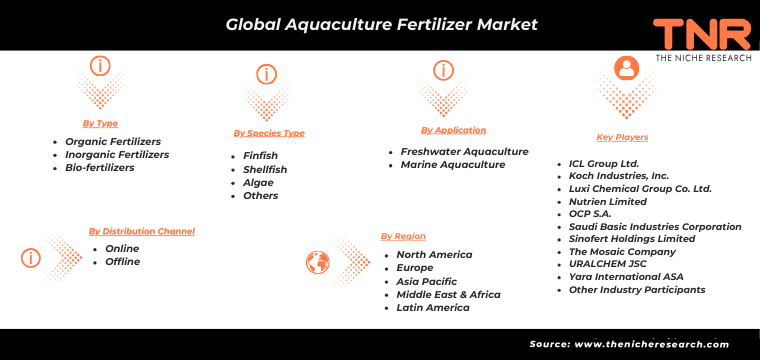The global aquaculture fertilizer market is driven by rising demand for sustainable aquaculture practices, increased fish consumption, advancements in aquaculture technology, and supportive government policies promoting aquaculture industry growth.
Driving Forces Behind the Boom of the Global Aquaculture Fertilizer Market
Rising Demand for Sustainable Aquaculture Practices: With increasing awareness about environmental conservation, there is a significant push towards sustainable aquaculture practices. This shift is driving the demand for specialized fertilizers that enhance productivity while minimizing ecological impact, thereby fostering market growth.
Increased Global Fish Consumption: As the global population continues to grow, so does the demand for fish as a primary source of protein. This surge in fish consumption is propelling the expansion of aquaculture operations, which in turn, boosts the need for effective aquaculture fertilizers to ensure high yields.
Advancements in Aquaculture Technology: Technological innovations in aquaculture are revolutionizing the industry. Improved methods for water quality management, nutrient delivery systems, and fertilizer application techniques are enhancing productivity and efficiency. These advancements are key drivers of the aquaculture fertilizer market, enabling higher output and better resource utilization.
Supportive Government Policies: Governments worldwide are implementing policies and providing incentives to promote the growth of the aquaculture sector. Subsidies, grants, and research funding are encouraging the adoption of modern aquaculture practices. Such supportive measures are crucial in driving the demand for aquaculture fertilizers, contributing to the market’s robust growth.
Key Trends Shaping the Future of Global Aquaculture Fertilizer Market
Integration of Organic Fertilizers: The shift towards organic and natural products is influencing the aquaculture fertilizer market. Organic fertilizers, derived from natural sources, are gaining popularity for their environmental benefits and ability to produce healthier fish, aligning with consumer preferences for sustainable and eco-friendly aquaculture practices.
Innovations in Nutrient Delivery Systems: Advanced nutrient delivery systems, such as controlled-release fertilizers and nanotechnology, are revolutionizing aquaculture. These innovations ensure precise nutrient delivery, reducing waste and optimizing growth conditions for aquatic organisms. This trend is enhancing efficiency and productivity, driving the market towards more sophisticated and effective solutions.
Focus on Water Quality Management: Ensuring optimal water quality is crucial for successful aquaculture operations. There is a growing emphasis on fertilizers that not only provide essential nutrients but also help maintain and improve water quality. This trend is shaping the market by promoting products that support overall ecosystem health.
Adoption of Precision Aquaculture: Precision aquaculture techniques, leveraging data analytics, IoT, and AI, are transforming the industry. These technologies enable real-time monitoring and management of nutrient levels, leading to more efficient fertilizer use. The adoption of precision aquaculture is driving demand for advanced fertilizers that can be seamlessly integrated into these systems.
Regional Variations in Global Aquaculture Fertilizer Market Growth
Asia Pacific (APAC): Asia Pacific leads in aquaculture fertilizer market growth due to its large aquaculture sector and high seafood consumption. Countries like China and India drive demand with investments in advanced fertilizers and sustainable practices, supported by favorable government policies.
North America: North America’s growth is fueled by technological advancements and rising seafood demand. The U.S. and Canada emphasize sustainable aquaculture and innovation in nutrient delivery systems, benefiting from robust research and supportive regulatory frameworks that drive market expansion.
Europe: Europe focuses on sustainability and environmental impact in aquaculture. Leading countries such as Norway and Spain are adopting organic fertilizers and advanced nutrient management systems, driven by stringent regulations and a strong consumer preference for eco-friendly aquaculture practices.
Latin America: Latin America experiences moderate aquaculture fertilizer market growth with key players like Brazil and Chile. The expansion of aquaculture activities is supported by investments in modern techniques, although challenges such as infrastructure limitations and regulatory issues impact full market potential.
Middle East and Africa: The Middle East & Africa region is seeing gradual growth in the aquaculture fertilizer market. Emerging aquaculture industries in countries like Egypt and South Africa are adopting modern fertilizers to enhance productivity, though market expansion is constrained by infrastructural and climatic challenges.
The global aquaculture fertilizer market is expanding rapidly, driven by rising seafood demand, technological advancements, and a shift towards sustainable practices. Regional growth varies, with Asia Pacific leading due to large-scale aquaculture operations, while North America, Europe, Latin America, and the Middle East & Africa show promising development with unique challenges.
Global Aquaculture Fertilizer Market Scope:

